Crucial M550 Review: 128GB, 256GB, 512GB and 1TB Models Tested
by Kristian Vättö on March 18, 2014 8:00 AM ESTRandom Read/Write Speed
The four corners of SSD performance are as follows: random read, random write, sequential read and sequential write speed. Random accesses are generally small in size, while sequential accesses tend to be larger and thus we have the four Iometer tests we use in all of our reviews.
Our first test writes 4KB in a completely random pattern over an 8GB space of the drive to simulate the sort of random access that you'd see on an OS drive (even this is more stressful than a normal desktop user would see). We perform three concurrent IOs and run the test for 3 minutes. The results reported are in average MB/s over the entire time.
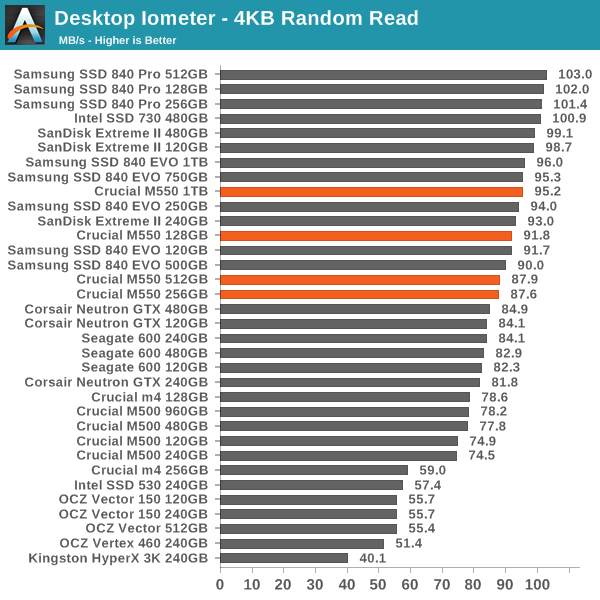
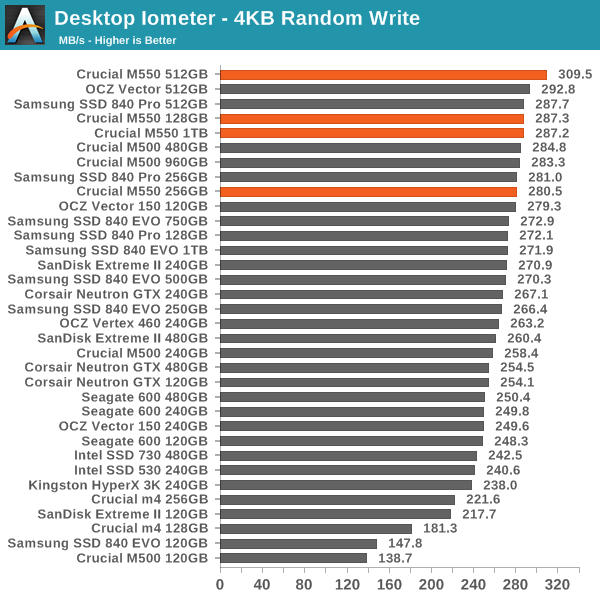
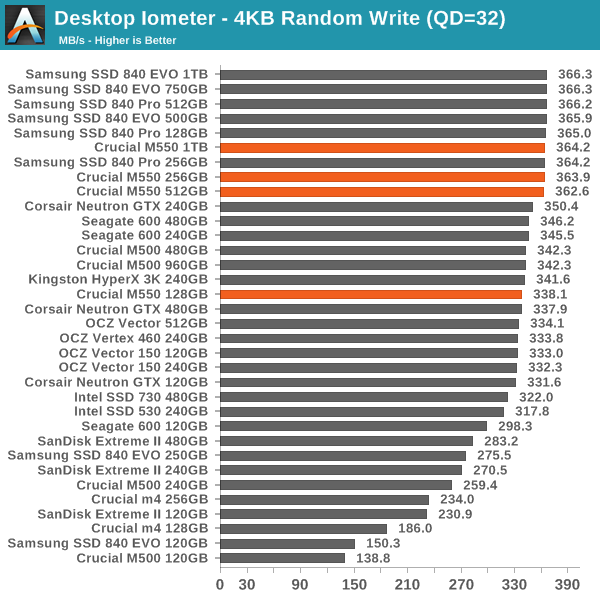
Random performance is strong when dealing with an empty drive but as the two previous pages show the big picture isn't as pleasant. The difference between 64Gbit and 128Gbit NAND is very clear here as the M550 is up to twice as fast as the M500 at the smaller capacities.
Sequential Read/Write Speed
To measure sequential performance I ran a 1 minute long 128KB sequential test over the entire span of the drive at a queue depth of 1. The results reported are in average MB/s over the entire test length.
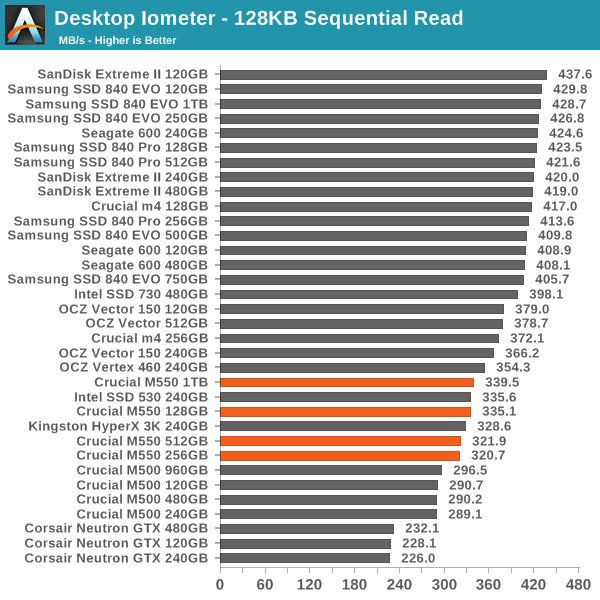
Sequential speeds are up quite a bit from the M500 as well but the read performance is still a bit lacking.
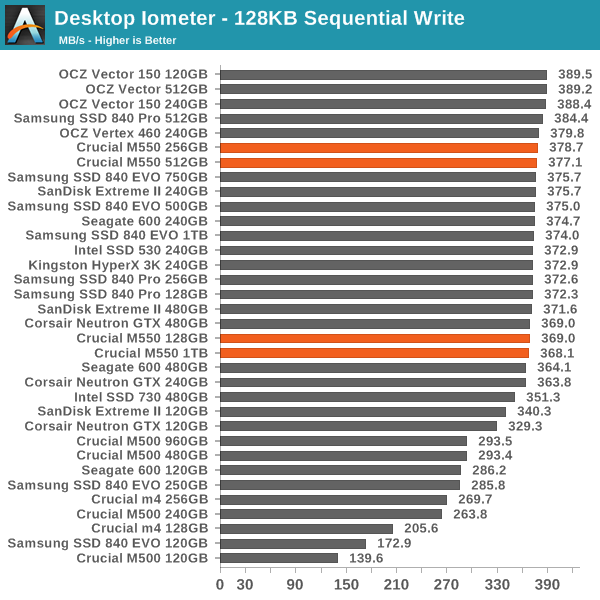
AS-SSD Incompressible Sequential Read/Write Performance
The AS-SSD sequential benchmark uses incompressible data for all of its transfers. The result is a pretty big reduction in sequential write speed on SandForce based controllers. Again, the M550 shows a decent improvement over the M500, particularly at the lower capacities.
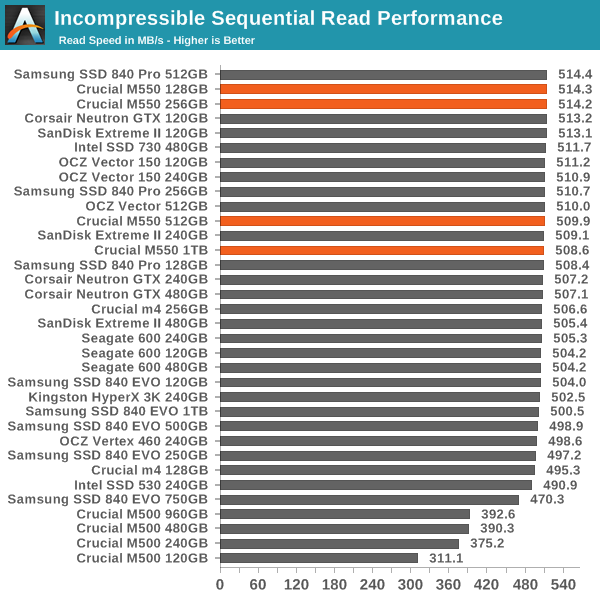
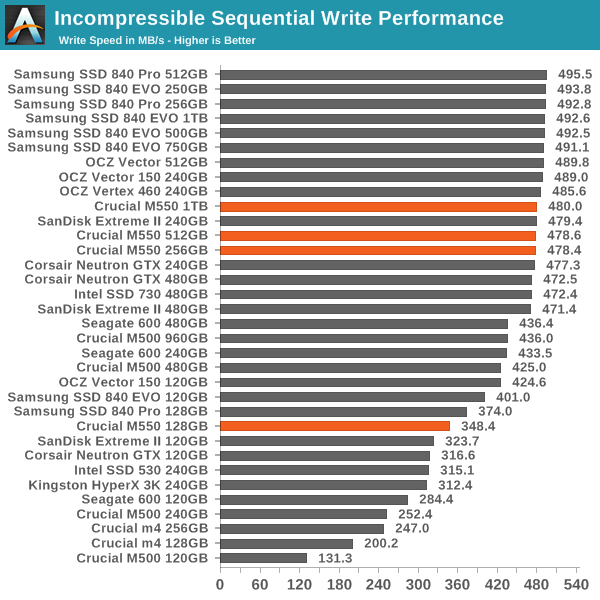










100 Comments
View All Comments
hojnikb - Thursday, March 20, 2014 - link
Thats only taking flash endurance into account. That doesn't mean controller wont crap on you years sooner.q.epsilon.p - Sunday, April 6, 2014 - link
Dude given that the 500M 480 and 550M 512 models are so different in price and so similar in performance I would go for the 480BG.Although the 500m 240 and 500m 120 perform much slower, but they were always slower compared to the competition so you had that information available before buying them. But considering its write speed where they really suffered I wouldn't have been much concerned.
and tbh you are not really going to notice the difference without benchmarks and the price difference is big enough to make it worth it.
Homeles - Tuesday, March 18, 2014 - link
The M500 being phased out doesn't make sense. Technically the M500 is more advanced with its 128Gb dies, despite its slower performance.elerick - Tuesday, March 18, 2014 - link
At first glance I tend to agree that this is a middle of the pack SSD. I however do seriously consider the power loss protection worth its weight in gold. I have a Samsung 830 and these days I value reliability above "good enough" performance. Once PCI-E SSD starts producing consumer priced drives I'll go that route.Death666Angel - Friday, March 21, 2014 - link
Can we boot off PCIe SSDs yet (consumer grade Windows)?hojnikb - Tuesday, March 18, 2014 - link
I really expected better consistency, but well... Maybe next time (or next firmware update ?).Although its nice to see they were able to boost write speed so much. Looks like smaller dies do pay off.
PS:
Anyone knows what native write accelaration stands for ? At first i though it was something like turbowrite (not knowing they will use 64Gbit flash) but this does not appear to be the case ...
Kristian Vättö - Tuesday, March 18, 2014 - link
Crucial specifically said they don't have an SLC or DRAM buffer and the write performance should be the same across all LBAs (the HD Tach graph shows that this is true). To me it sounds like the Native Write Acceleration is just a marketing trick aimed at Samsung and others who use buffers to boost performance.hojnikb - Tuesday, March 18, 2014 - link
Yeah it appears so.It really nice to see, that they aren't using any nasty tricks like turbowrite, just to inflate numbers.
jospoortvliet - Thursday, March 20, 2014 - link
I think turbowrite is an awesome idea - it helps exactly where consumers need it... Short write bursts. Sure, not that interesting for pro use perhaps but isn't that the point of consumer products?hojnikb - Thursday, March 20, 2014 - link
Awsome idea for marketing department maybe. Considering that your avarage joe only looks at the sequential speeds, it makes EVO compared to lets say m500 a way way better drive, even though in reality thats not the case.Its not like turbowrite is bad or anything (i think it a great solution for "slow" write devices such as TLC) but i just hate that they are fooling people (they could easily market both normal speeds and turbo speeds)